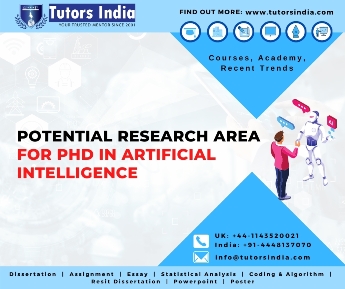Potential Research Area for PhD in Artificial Intelligence
Abstract:
Artificial Intelligence (AI) is focusing on one of the most significant elements that could bring a remarkable change to human life. Other emerging technologies include the Internet of Things (IoT), Big Data, Machine Learning. These technologies are the unlimited and unpredictable possible source, and no one knows how they could change the world in the future. The deeper you learn about AI, the scarier you will find. We are in the most precious time of our kind. There is nothing that can stop us, from finding out space to getting our hands on human genetics. We can modify the weather; even if we are not paying attention to it. Even though AI is one thing that is uncontrollable, carrying out a dissertation in AI will enable and contribute to intelligence. 1

Applications of Artificial Intelligence
The reach of Artificial Intelligence is constantly growing and is used now in many domains. Automated reasoning is the first step in artificial intelligence programming. It is a program that considers some encoded data about the world as input and presents secondary conclusions based on the data provided as output. At first, this automated reasoning programming was merely considered academic. But today, it is used in air traffic control systems, video games, and the Mars rover. 2
In the present century, AI has been significantly used in any area of research and in all fields: Science, engineering, medicine, education, business, finance, accounting, marketing, stock market, economics, and law, among many others. Since the intelligence of machines, the range of AI has grown tremendously with machine learning capabilities and also has produced profound impacts on governments, businesses, and society. Artificial intelligence is used in solving major issues like supply chain management, logistics, optimization of energy resources, waste management, etc. Also in smart production, AI can be incorporated into green manufacturing processes for better environmental policies. 3
Recent Trends in AI
There are several factors that fueled the revolution in AI. Most important among them is the budding of machine learning, supported partly by cloud computing resources and web-based data gathering which is extensive. Machine learning technologies have been pushed in a forward direction by Deep learning, which is a type of adaptive artificial neural network. Following are the recent trends in AI.
- Large-scale machine learning: Many of the machine learning issues like supervised and unsupervised learning are well-understood. A major effort has been made to balance existing algorithms to handle exceptionally large data sets.
- Deep learning: The convolutional neural networks that have been trained successfully have benefited the field of computer vision, and several applications like video labeling, object recognition, activity recognition, and several others. This technology has also benefited many areas of insight, such as speech, audio, and natural language processing.
- Robotics: Robotic navigation has been mainly solved in static environments. Current efforts have been made to train a robot to communicate with the world in more generalized and conventional ways. Another major topic of current interest that arises in interactive environments is manipulation. Influence in robotics is only the beginning of the deep learning revolution.
- Computer vision: The most well-known form of machine perception in computer vision. It is the sub-field of AI which has been transformed by the rise of deep learning.
- Natural Language Processing: This technology is another active area of machine perception and often coupled with automatic speech recognition. 5
Latest Topics in Artificial Intelligence
1. Rule-Based Expert Systems for Image Understanding: Recently several expert systems for image processing were proposed. The aim of the rule- based expert system is to take knowledge from a human expert and convert this into a number of hardcoded rules to apply to the input data.
2. Spatial Structure and Function in Diagnosis: Structures are related to objects – associated visual information that remains constant within the period of observation. Functions display with changes either in relation to contemporary structures or to the background or to both. Structures are usually visible in hierarchical spatial order, functions in both spatial and time oriented order.
3. Device Modeling for a Versatile Maintenance Expert System: VMES is a device-model-based versatile maintenance expert system for the domain of digital circuits. The objective of VMES is to interact with a maintenance technician to identify the specific faulty components or connections of a malfunctioning circuit.
4. A Computational Theory of Word Recognition: Computational theory of word recognition has proven to be a valuable approach in developing theories of spoken-word processing. In this paper, we focus on a particular class of theories in which it is assumed that the spoken-word recognition process consists of two consecutive stages, with an `abstract’ discrete symbolic representation at the interface between the stages.
5. Selection and Use of Image Features in Early Visual Processing: The visual system is constantly bombarded with information originating from the outside world, but it is unable to process all the received information at any given time.
6. Machine Understanding and Data Abstraction: The main scope of this topic is machine learning and temporal abstraction methods and their application in medical diagnosis. It includes selection of methods and diagnostic domains, and also the performance or viability of approaches.
7. Blockchain in healthcare: Blockchains in healthcare can be envisaged in five primary areas: Managing electronic medical record (EMR) data. Protection of healthcare data. Personal health record data management.
8. AI for sustainability: AI can be a net positive contributor to environmental sustainability in many industries. Here are some examples: In agriculture, AI can transform production by better monitoring and managing environmental conditions and crop yields. AI can help reduce both fertilizer and water, all while improving crop yields. 6
Conclusion:
There are a huge variety of technologies and applications of AI that can be explored in the dissertation. It is significant to conduct many types of research relating to AI in the future. 4 The engagement of researchers with challenges posed due to the research in AI is unlimited. Some research topics, like the similarity and difference between analysis of the future and religious eschatology, have been well focused, with strong argumentations and reasonably obvious conclusions. Other topics such as the radical transformations that are already causing our society and our relation to one another still needs a deep theological evaluation. 7
Tutorsindia offers Artificial Intelligence and Machine Learning thesis help includes Deep Learning, Robotics, Natural Language Processing, Reinforcement Learning, Artificial Neural Network, Expert Systems, Fuzzy Systems, Computer Vision, Biometrics, Computational Biology
References:
1. Hung Nguyen, 2020, Artificial Intelligence And Its Impact On Workforce.
2. Nicholas S Dunnuck, 2019, The Effect Of Emerging Artificial Intelligence Techniques On The Ethical Role Of Computer Scientists.
3. Raffaele Cioffi, Marta Travaglioni, Giuseppina Piscitelli, Antonella Petrillo, and Fabio de Felice, 2020, Artificial Intelligence And Machine Learning Applications In Smart Production: Progress, Trends, And Directions.
4. Jennifer Johansson, Senja Herranen, Brian Mccauley, 2019, The Application Of Artificial Intelligence (Ai) In Human Resource Management: Current State Of AI And Its Impact On The Traditional Recruitment Process.
5. Barbara J. Grosz, Russ Altman, Eric Horvitz, Alan Mackworth, Tom Mitchell, Deidre Mulligan, Yoav Shoham, 2020, ARTIFICIAL INTELLIGENCE AND LIFE IN 2030.
6. Recent and Current Artificial Intelligence Research in the Department of Computer Science, State University of New York at Buffalo Shoshana L. Hardt & William J. Rapaport, 2021
7. Recent advances in Artificial Intelligence (AI) and some of the issues in the theology & AI dialogue Marius Dorobantu, 2021

 Previous Post
Previous Post